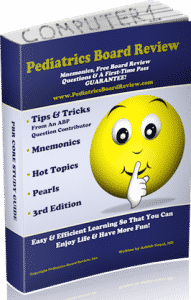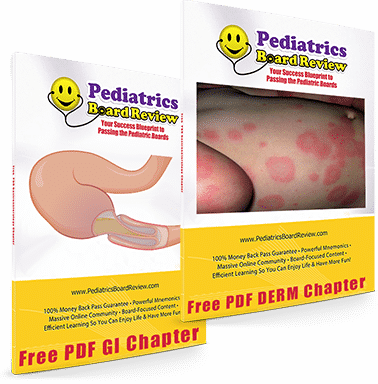Improving In-Training Exam Scores: Tip #3 – Propinquity!
Tip #3 – Propinquity!
Propinqua-what? And what does that have to do with improving in-training exam scores?
The word is PROPINQUITY!
In a recent article titled, “Tips #1 & 2 – Start Early & Work Smart!” I talk about the direct correlation between residency in-training exam scores and the number of hospital admissions a resident does. I also discuss a study which shows that in-training exam scores do in fact act as indicators of a resident’s ability to pass the board certification exam.
In this article, I’ll talk about improving in-training exam scores by using propinquity. I was recently introduced to the idea of propinquity while reading Influencer: The Power to Change Anything, by Kerry Patterson. The book discusses strategies used by some of the most influential people around the world to influence change in all different aspects of life.
Webster defines propinquity as “nearness in place or time.” In the book, one of the sources of influence is the environment. The idea here is that that in many situations, you can effect change by modifying the environmental relationship of one variable with another. By altering the relationship of place or time between variables.
Now, let’s think of an example of how this concept might be utilized within pediatric residency programs to increase in-training exam scores.
 Meet this set of twin sisters, Dr. Tracy Smith and Dr. Penny Smith. Both went to the same college. Both went to the same medical school. Both scored similarly on the MCAT as well as their USMLE Step exams. Their scores were never amazing, but they did well enough to pass. They’re both now pediatric residents, but they matched at neighboring hospitals down the street from each other.
Meet this set of twin sisters, Dr. Tracy Smith and Dr. Penny Smith. Both went to the same college. Both went to the same medical school. Both scored similarly on the MCAT as well as their USMLE Step exams. Their scores were never amazing, but they did well enough to pass. They’re both now pediatric residents, but they matched at neighboring hospitals down the street from each other.
TRACY’S RESIDENCY PROGRAM EXPERIENCE
You’re probably very familiar with her type of residency program. On a typical call night, Tracy might see a dehydrated patient with hyponatremia. She might even see something really interesting, like a child in crisis from a metabolic syndrome, such as Maple Syrup Urine Disease (MSUD). After discussing the history, differential, assessment and workup with her upper level resident and/or attending pediatric physician, she retreats to the pediatrics’ resident lounge to type up the H&P.
 Tracy feels like she’s learned a lot, has a solid assessment and plan based on the discussion she had with her attending physician, and she then essentially transcribes the discussion into an admission H&P and signs it. She then sits down on a chair, kicks up her feet onto the coffee table, picks up the remote control, turns on the TV, watches a rerun of Grey’s Anatomy, and waits for the next admission. On a different night, she might even use the time to look through Nelsons’s, or visit PubMed online, in order to prepare for a morning report.
Tracy feels like she’s learned a lot, has a solid assessment and plan based on the discussion she had with her attending physician, and she then essentially transcribes the discussion into an admission H&P and signs it. She then sits down on a chair, kicks up her feet onto the coffee table, picks up the remote control, turns on the TV, watches a rerun of Grey’s Anatomy, and waits for the next admission. On a different night, she might even use the time to look through Nelsons’s, or visit PubMed online, in order to prepare for a morning report.
PENNY’S RESIDENCY EXPERIENCE
Tracy's twin sister, Penny, has a fairly similar residency program. The pass rate for the American Board of Pediatrics’ initial certification exam has been matching the national average of approximately 75% – 80%. In-training exam scores have also been fairly average, and both numbers have mirrored the overall numbers at Tracy’s residency program.
 This year, though, Penny’s residency Program Director has decided to try something different. She’s decided to buy 5 copies of the PBR core study guide and the PBR Q&A book. She’s placed a copy of the book next to each of the 3 computers and labeled them COMPUTER 1, COMPUTER 2 and COMPUTER 3. She’s also placed two copies of the book on the coffee table next to the remote controls, and labeled them TABLE 1 and TABLE 2.
This year, though, Penny’s residency Program Director has decided to try something different. She’s decided to buy 5 copies of the PBR core study guide and the PBR Q&A book. She’s placed a copy of the book next to each of the 3 computers and labeled them COMPUTER 1, COMPUTER 2 and COMPUTER 3. She’s also placed two copies of the book on the coffee table next to the remote controls, and labeled them TABLE 1 and TABLE 2.
That’s it. It’s two, simple changes that have been made by Penny’s residency Program Director with the idea of propinquity in mind.
Now imagine Penny’s nights on call. She also admits a similar pediatric patient population. She also discusses the cases in detail with her upper level residents and pediatric attending physicians. She also transcribes the discussions into an H&P, and sometimes has a small break between admissions. But how might the changes made by her Program Director affect Penny's residency experience?
TRADITIONAL TRACY VERSUS PROPINQUITOUS PENNY
Keeping the idea of propinquity in mind, let's see how Penny’s educational experience might be different going forward when compared to Tracy’s. By investing in just a few copies of the number #1 pediatric study guide on Google and placing them next to computers and remote controls, her Program Director has made a high-yield, board-focused resource visible and accessible to Penny.
 Do you think it might just be possible that Penny would browse through the study guide next to the computer as she’s typing up that H&P? Or she might choose to look over the section on Maple Syrup Urine Disease, or hyponatremia, or dehydration in order to quickly review the highest-yield facts and most tested aspects of those disorders? And for those nights when Penny has to prepare for a morning report, she might choose to start her research by looking through the topic summary within a copy of the Pediatrics Board Review (PBR) on the coffee table instead of reaching for that massive book known as Nelson’s, or surfing online through that overwhelming resource known as PubMed for information? I do.
Do you think it might just be possible that Penny would browse through the study guide next to the computer as she’s typing up that H&P? Or she might choose to look over the section on Maple Syrup Urine Disease, or hyponatremia, or dehydration in order to quickly review the highest-yield facts and most tested aspects of those disorders? And for those nights when Penny has to prepare for a morning report, she might choose to start her research by looking through the topic summary within a copy of the Pediatrics Board Review (PBR) on the coffee table instead of reaching for that massive book known as Nelson’s, or surfing online through that overwhelming resource known as PubMed for information? I do.
Now, assuming all things being equal between these two sisters, and the two residency programs, which sister do you think will score better on her next in-training exam? And which sister do you think will have a better chance of passing one of the most difficult medical board certification exams? Traditional Tracy or Propinquitous Penny?
INFLUENCER
 I loved reading Influencer because it gave me some great ideas about how to possibly effect change in India through my nonprofit organization, AVSAR. Other ideas that Influencer brought up include “making things easy” and “making the invisible visible.” Propinquitous Penny’s residency Program Director actually seems to have satisfied the concepts of propinquity and the idea of making things easy. To some degree, she’s also made the invisible more visible. She's a forward thinker, and it's possible that next year she'll even take on an idea that other Program Directors have entertained to satisfy all 3 of the above concepts… purchase, or subsidize the purchase of, the PBR Ultimate Bundle Pack for all pediatric residents. With the Ultimate Bundle Pack, residents have access to the hardcopy version of both books, online versions of both books, and even iPad/iPhone accessible versions of the Pediatrics Board Review (PBR).
I loved reading Influencer because it gave me some great ideas about how to possibly effect change in India through my nonprofit organization, AVSAR. Other ideas that Influencer brought up include “making things easy” and “making the invisible visible.” Propinquitous Penny’s residency Program Director actually seems to have satisfied the concepts of propinquity and the idea of making things easy. To some degree, she’s also made the invisible more visible. She's a forward thinker, and it's possible that next year she'll even take on an idea that other Program Directors have entertained to satisfy all 3 of the above concepts… purchase, or subsidize the purchase of, the PBR Ultimate Bundle Pack for all pediatric residents. With the Ultimate Bundle Pack, residents have access to the hardcopy version of both books, online versions of both books, and even iPad/iPhone accessible versions of the Pediatrics Board Review (PBR).
Can you imagine a residency program in which every single resident physician has a copy of a high-yield, board-focused study guide that’s in front of them while typing notes, while sitting around the coffee table at work, and while at home on days off? Do you think that such a progressive and propinquitous residency program’s in-training exam scores and first-time pass rates for the initial board certification exam for the American Board of Pediatrics (ABP) just might increase significantly by these two simple changes?
Now…. I challenge you to think about how you can utilize these concepts in your own life to effect positive change. I’d love to hear your thoughts below. Simply type in a comment below. I promise to ready every single one! And you KNOW I love efficiency, so if you want to read more about Influencer, just click here for an amazing book summary.

Watch Your Free Video Training Session Now
Learn HOW to Answer Board Style Questions &
Be a Better Test Taker



